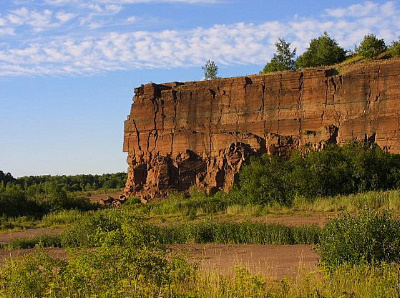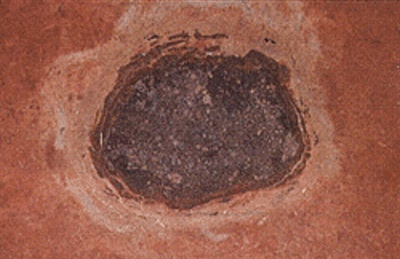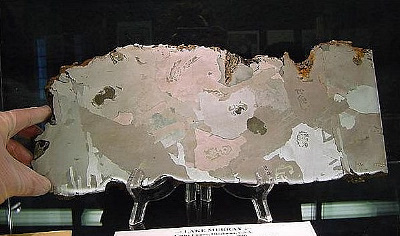IMCA Insights – April 2009
About Old and Fossil Meteorites
by Norbert Classen
When we are talking about "old meteorites" in this article we are not referring to the absolute age of those meteorites - most of them crystallized during the formation of our solar system, and have absolute ages of about 4.6 billion years! We are talking about their terrestrial ages instead, the time between their initial fall until the present day. Some meteorite finds have been protected from weathering away by hot or cold desert environments while others were literally fossilized, and thus preserved for several million years.
The Oldest Meteorite Finds
Most meteorites weather away quite quickly in the oxidizing environment of the Earth, while some meteorites may literally be observed as they rust away. However, other meteorites fell at more fortuitous locations and were preserved until this day, such as in the blue-ice fields of Antarctica or in the hot deserts of Africa. Many desert chondrite finds have been preserved for as long as 40,000 years while some achondrites exhibit much longer terrestrial residence times. With a terrestrial age of about 500 ka (500,000 years) lunar meteorite Dhofar 025 from Oman is the current record holder for hot deserts, closely followed by lunar find Dhofar 908 with a terrestrial age of 360 ka, and the martian find Dhofar 019 with a terrestrial residence time of 340 ka.
Lunar meteorite
Dhofar 908 fell about 360,000 years ago
(Photo © by Norbert Classen)
There is even one non-desert find, the eucrite Rio Cuarto 001 from Argentina, with a terrestrial age of 410 ka - another find that shows that the metal-poor achondrites have a much better expectancy in the terrestrial environment than chondrites. A few Antarctic meteorite finds are even older than the finds mentioned above, but they are all young compared to a number of finds that have been preserved in sediments, or other geologic strata conducive to preservation: the so-called "fossil meteorites".
Fossil Meteorite Charts
| Meteorite | Find | Class | Age° |
| Österplana | Sweden, 1987 | L chondrite | 480 |
| Gullhögen | Sweden, 2000 | L chondrite | 470 |
| Brunflo | Sweden, 1980 | H chondrite | 463 |
| Lake Murray | USA, 1933 | IIAB iron | 120 |
| "Hawaii" (Kyte) | Hawaii, 1998 | CM chondrite | 65 |
| Sardis* | USA, 1940 | IAB iron | 5-23 |
| Gay Gulch* | Canada, 1901 | IAB iron | 2-5 |
| Skookum* | Canada, 1905 | IVB iron | 2-5 |
| Ider | USA, 1957 | IIIAB iron | 3.1 |
| Tamarugal | Chile, 1903 | IIIAB iron | 2.7 |
|
* estimate based on strata
ages ° ages given in million years (ma) |
|||
The oldest of these fossils is the meteorite of Österplana, Sweden, which was found in 1987 imbedded in some limestone. This limestone, which dated from Ordovician times, revealed to the scientists that the imbedded meteorite had fallen 480 million years ago!
Kinnekulle Quarry, Sweden - Find Location of the Österplana Meteorite
The Österplana
Meteorite - A Fossil L Chondrite
(Photo © B. Schmitz & M. Tassinari)
The meteorite of Österplana is even older than the Brunflo meteorite which previously held the record for the "oldest". Brunflo, which was also found in Swedish limestone in 1980, has a terrestrial age of about 460 million years. As with true fossils, most of the original meteoritic minerals in fossil meteorites have been replaced by terrestrial minerals leaving only the outer structure of the meteorite preserved. Although both meteorites have been classified as chondrites, only their chondritic structure remains as evidence of their extraterrestrial origins.
Slice of the Lake
Murray IIAB Iron which fell 120 Million Years ago
(Photo © Rob Elliott, Fernlea)
The oldest
intact meteorite is the Lake Murray iron. A single mass with a massive
iron-shale was found in a gully in Oklahoma, USA, in 1933. The meteorite
was imbedded in some Antler Sandstone dating from the Lower Cretaceous,
suggesting that Lake Murray landed in a near shore, shallow sea, while
these beds were being deposited about 120 million years ago! In
addition, although the exterior of this meteorite has been heavily
corroded, the nickel-iron core has remained unaltered. It literally fell
in times when dinosaurs still ruled the Earth! For further information
on fossil meteorites please visit the comprehensive
Fossil Meteorites Page, compiled by
Channon Visscher.
•
IMCA Home Page •
IMCA Code of Ethics •
IMCA Member List
•
Join IMCA •
IMCA Meteorite Info


